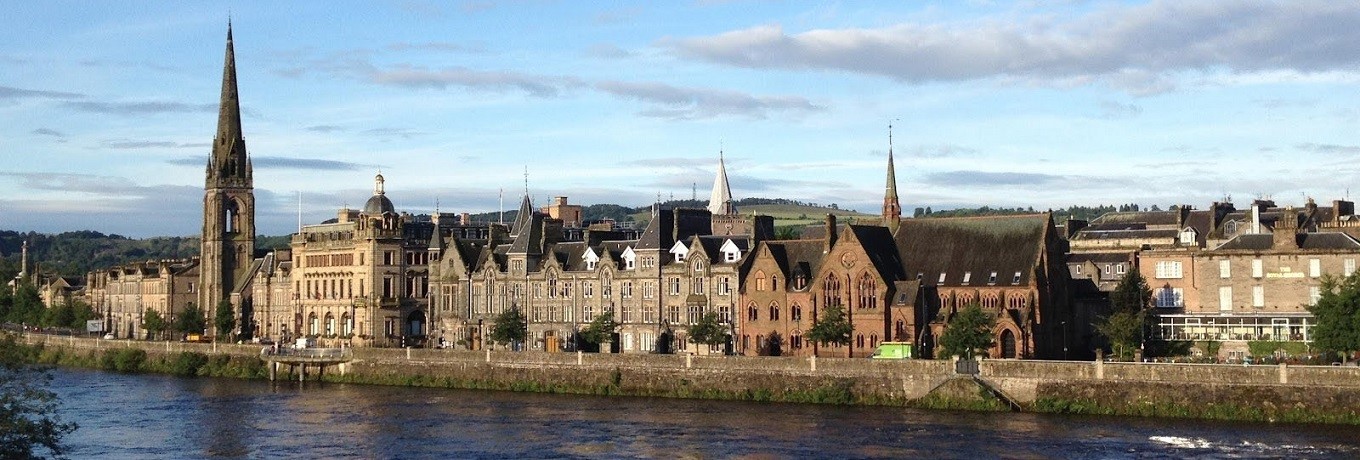A HISTORY OF PERTH IN THE MIDDLE AGES
Perth is where I lived 20 odd years and like it, overflowing with history … The fair city (as it’s known) of Perth was made a burgh by King David I in the early 12th century (that’s the 1100’s by the way). There was already a settlement here, where the River Tay could be crossed – as the Romans found out. Ships could easily sail up the river to Perth. In the middle ages, Perth was a busy inland port and had a manufacturing centre. Wool was woven in Perth, it was then fulled, meaning it was beaten in a mixture of water and clay to thicken and clean it. At first, the wool was trodden into the water and clay by human feet. (The men who did this were called walkers). Later the wool was pounded by wooden hammers worked by watermills. There was also a leather industry in medieval Perth, leather was used to make things like gloves (we do have a Glover St) and shoes. There were also horners. In the middle ages, cow and goat horn was used to make spoons, combs and ink wells. Aye, and craftsmen – butchers, bakers, and blacksmiths.
In 1231 Dominican friars came to Perth. Dominicans were known as black friars because of their black costumes. Carmelites of white friars came to Perth in 1260. Franciscans or grey friars came to Perth in 1460. To this day we still have areas of the city known as Whitefriars, Greyfriars and Blackfriars. In 1429 a small monastery was founded for Carthusian monks, the only ‘hospitals’ were run by the church, there were 5 . In them, monks looked after the sick and the poor as best they could. (They also provided hospitality for poor travelers). There was also a leper hostel outside the town. In 1210 King William the Lion made it a royal burgh.
Perth was defended by a ditch and an earth rampart with a wooden palisade on top. The town was occupied by the English from 1296 to 1313. In 1304 the English king ordered that stone walls be built around Perth. However, when the Scots re-captured Perth in 1313 they destroyed these walls to prevent the English occupying Perth again. In 1329 Robert the Bruce was succeeded by his 5 year old son. In 1332 Edward Balliol, the son of King John landed in Fife with his supporters. They fought a battle against the regent at Musselburgh. Balliol captured Perth and he was crowned King of Scotland. Civil war followed. Balliol’s forces held Perth until 1339, with English support. It was relatively easy for them to hold Perth because it was a port. Perth could be supplied water. Jumpig to 1396 and we saw the battle of the clans. Two clans or federations of clans were feuding and the king asked them to settle their differences by choosing 30 champions who would fight each other. The two sides fought on the North Inch. King James I was assassinated by nobles in Perth in 1437 and today you can see exactly where it happened, in the cellar of Paul’s local pub, named King James by some chance. In January the king and queen were staying in the black friary. At midnight rebels led by Robert Graham broke into his rooms and stabbed him 16 times. The queen and her children escaped to Edinburgh. Perth was then NOT the capital, not after this.
16th CENTURY AND 17th CENTURY was one of the birthplaces of the Scottish Reformation. In 1544 6 people were executed in Perth for heresy, in 1559 John Knox made a rousing sermon in St Johns Kirk. He claimed that the Catholic mass was idolatry, the audience responded by smashing the high altar, then went on to destroy the friaries and monasteries. Following the reformation, St John’s Kirk was divided into 3 separate kirks.
In 1600 came the Gowrie conspiracy. According to King James VI, he was hunting at Falkland when the Earl of Gowrie’s brother, Alexander Ruthven asked him to come to Gowrie House. Ruthven supposedly told the king that they had a man with a container of foreign coins at the house. The king eventually went with a group of companions. The king was led to a room in a turret by Ruthven who then locked the door. According to the king, Ruthven then threatened him with a dagger. Meanwhile, the companions of the king were told that the king had left and they were about to leave as well. However, the king opened a window and called for help. The king’s companions rushed to the room and killed Ruthven. The Earl of Gowrie then rushed to the scene with his servants and in the ensuing fight, he was killed. It is believed by many that the conspiracy was stage managed by the king to get rid of a family he disliked. Who’d be a king eh? By the late 16th century Perth probably had a population of around 6,000. By the standards of the time, it was a large town. Perth suffered from outbreaks of plague. It struck in 1512, 1585-87 and again in 1608 and 1645.King James VI’s hospital was built in 1569. (The present building is mid-18th century). A bridge was built across the Tay in 1616 but it only lasted for 5 years. It was destroyed by severe storms and flooding. The Fair Maid’s House dates from the early 17th century and is still here. In 1644 the Royalist Marquis of Montrose captured Perth after he won the battle of Tippermuir. Charles II was crowned king at Scone in 1651. However, in August 1651 an English army captured Perth. Cromwell built a fort on the South Inch but it was demolished in 1661.
It is a wee place of some 45,000 people nowadays, you can walk the High Street from end to end in ten minutes. We are full of charity shops, hairdressers and nail shops. Plenty of pubs, a good museum, all waiting for your stay over, what are you waiting for?

